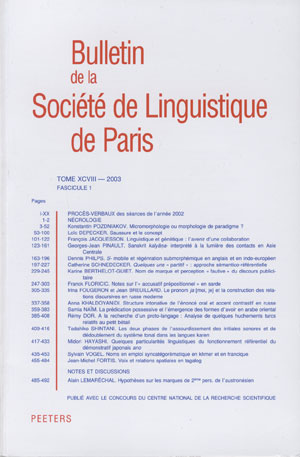 previous article in this issue previous article in this issue | next article in this issue  |

Preview first page |
Document Details : Title: Sur la nature du «signifié de langue» Subtitle: Réflexions de lexicographie Author(s): MARTIN, Robert Journal: Bulletin de la Société de Linguistique de Paris Volume: 102 Issue: 1 Date: 2007 Pages: 17-33 DOI: 10.2143/BSL.102.1.2028197 Abstract : Pour représenter le «signifié de langue», le lexicographe recourt à des structures arborescentes. Or, pour un même mot, ces représentations varient considérablement d’un dictionnaire à l’autre. Cela se comprend: les critères de classification sont en très grand nombre, et il existe toujours, pour les hiérarchiser, une pluralité de possibles. Tout donne à penser qu’un espace bidimensionnel est inadapté à un tel objet. On fait ici l’hypothèse que le «signifié de langue» est un objet multidimensionnel: à chacun de ses aspects serait attachée une dimension particulière. S’il est impossible, à supposer que l’hypothèse soit pertinente, d’en tirer aucune conséquence pour la lexicographie traditionnelle (sur papier), la lexicographie informatisée, gouvernée par des systèmes hypertextuels, pourrait en revanche conduire à des solutions novatrices et peut-être plus appropriées. The lexicographer represents the «tongue significate» by means of tree-shaped structures. However one and the same word is to be illustrated by representations widely different from one dictionary to another. This is to be expected since the classifying criteria are very numerous and there are always various possible ways of arranging their hierarchy. One is led to think that a bi-dimensional space is inadequate for such an item. We propose the hypothesis that the «tongue significate» is a multi-dimensional item, each of its aspects requiring a particular dimension. If it remains impossible — supposing our assumption is relevant — to apply any of its conclusions to traditional lexicography on paper, the computational lexicography, on the other hand, based on hypertext links, might bring about innovative and possibly more adequate solutions. Zur Darstellung des Signifiés, bedient sich der Lexikograph verzweigter Strukturen. Diese Darstellungen können für ein und dasselbe Wort von einem Wörterbuch zum anderen erheblich voneinander abweichen. Das ist leicht zu erklären: es gibt eine große Anzahl von Klassifikationskriterien und die Möglichkeiten ihrer Hierarchisierung sind vielfältig. Man kann davon ausgehen, dass ein bidimensionaler Raum für ein solches Objekt nicht angepasst ist. Wir gehen deshalb hier von der Hypothese aus, daß der Signifié ein mehrdimensionales Objekt ist: jedem seiner Aspekte ist eine spezielle Dimension zugeordnet. Wenn diese Hypothese richtig ist, ist es jedoch unmöglich, daraus eine Lösung für die herkömmliche Lexikographie (auf Papier) herbeiführen; dagegen könnte die elektronische Lexikographie mit ihrem hypertextuellen Verweissystem zu neuen und vielleicht geeigneten Lösungen führen. |
|


